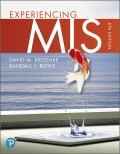
A)
Explanation of Solution
Systems Thinking:
System thinking is a management discipline which involves identifying and understanding the components of a system and modeling the system by connecting the input and output of the components.
Importance of Systems thinking to business professionals:
- Business people often face situati...
B)
Explanation of Solution
Systems thinking and Moore’s law:
Moore’s Law:
Moore’s Law is coined by Gordon Moore, the co-founder of Intel Corporation, which states that the since the integral circuit has been invented, the number of transistors per square inch in it has been doubled every two years. As the computers are getting exponentially faster, the cost of data processing is approaching zero.
System thinking to explain the reasons for which the farmer digs up a field of pulpwood trees:
- In the production of paper the input are the pulpwood trees...
C)
Explanation of Solution
Systems thinking with regard to consequences of Bell’s Law, Moore’s law or Metcalf’s Law:
Bell’s Law:
Bell’s Law is coined by Gordon Bell in 1972, which states that in every decade a new computer class is formed which establishes a new industry.
- As said by Gordon Bell digital devices will be evolved very quickly and this will enable new platforms and industries in every 10 years, one can use system thinking to deduce that currently the market is run by products of smart phones, tablets and smart watches.
- In next 10 years new wearable technological devices with implementation of augmented reality and virtual reality may rule the market.
Moore’s Law:
Moore’s Law is coined by Gordon Moore, the co-founder of Intel Corporation, which states that the since the integral circuit has been invented, the number of transistors per square inch in it has been doubled every two years. As the computers are getting exponentially faster, the cost of data processing is approaching zero...
D)
Explanation of Solution
Jennifer’s failure to display system thinking:
- Jenifer failed to display system thinking skills as for the firms supply chain Flextime she was unable to create a model which could have been beneficial for her to understand about the operations ...
E)
Explanation of Solution
Ways by which people can improve their system thinking skills:
“Yes”, system thinking can be improved as system thinking skills are correlated with IQ which is dependent on visual and auditory skills...
Want to see the full answer?
Check out a sample textbook solution
Chapter 1 Solutions
EBK EXPERIENCING MIS,
- What significant justification is there for the -> operator in C and C++?arrow_forwardMultidimensional arrays can be stored in row major order, as in C++, or in column major order, as in Fortran. Develop the access functions for both of these arrangements for three-dimensional arrays.arrow_forwardWhat are the arguments for and against Java’s implicit heap storage recovery, when compared with the explicit heap storage recovery required in C++? Consider real-time systems.arrow_forward
- 8. Name and Email AddressesWrite a program that keeps names and email addresses in a dictionary as key-value pairs. The program should display a menu that lets the user look up a person’s email address, add a new name and email address, change an existing email address, and delete an existing name and email address. The program should pickle the dictionary and save it to a file when the user exits the program. Each time the program starts, it should retrieve the dictionary from the file and unpickle it. How would the user be able to use the program?arrow_forwardPlease solve and answer the question correctly please. Thank you!!arrow_forwardPlease solve and answer the question correctly please. Thank you!!arrow_forward
- W AutoSave Off File Home Insert Draw Design Assignment_1[1] - Protected... ■ Saved V > Search Layout References Mailings Review View Help QuillBot RefWorks - RCM PROTECTED VIEW Be careful-files from the Internet can contain viruses. Unless you need to edit, it's safer to stay in Protected View. Enable Editing PR Comments Viewing Share × 2. The following state transition table is a simplified model of process management, with the labels representing transitions between states of READY, RUN, BLOCKED, and NONRESIDENT. READY RUN BLOCKED NONRESIDENT READY RUN - 1 - 5 BLOCKED 2 4 3 - 6 Give an example of an event that can cause each of the above transitions. Draw a diagram if that helps. (5) Page 2 of 4 20 of 278 words Text Predictions: On 64 f W Focus + 170% ENG US 17:13 2025/03/24arrow_forwardI need help understanding how could I got the IP Address for the Last Host on this Subnet & the Broadcast Address for this Subnetarrow_forwardI need help understanding how could I got the IP Address for the Last Host on this Subnet & the Broadcast Address for this Subnetarrow_forward
 Fundamentals of Information SystemsComputer ScienceISBN:9781305082168Author:Ralph Stair, George ReynoldsPublisher:Cengage Learning
Fundamentals of Information SystemsComputer ScienceISBN:9781305082168Author:Ralph Stair, George ReynoldsPublisher:Cengage Learning Principles of Information Systems (MindTap Course...Computer ScienceISBN:9781285867168Author:Ralph Stair, George ReynoldsPublisher:Cengage Learning
Principles of Information Systems (MindTap Course...Computer ScienceISBN:9781285867168Author:Ralph Stair, George ReynoldsPublisher:Cengage Learning Database Systems: Design, Implementation, & Manag...Computer ScienceISBN:9781305627482Author:Carlos Coronel, Steven MorrisPublisher:Cengage Learning
Database Systems: Design, Implementation, & Manag...Computer ScienceISBN:9781305627482Author:Carlos Coronel, Steven MorrisPublisher:Cengage Learning Database Systems: Design, Implementation, & Manag...Computer ScienceISBN:9781285196145Author:Steven, Steven Morris, Carlos Coronel, Carlos, Coronel, Carlos; Morris, Carlos Coronel and Steven Morris, Carlos Coronel; Steven Morris, Steven Morris; Carlos CoronelPublisher:Cengage Learning
Database Systems: Design, Implementation, & Manag...Computer ScienceISBN:9781285196145Author:Steven, Steven Morris, Carlos Coronel, Carlos, Coronel, Carlos; Morris, Carlos Coronel and Steven Morris, Carlos Coronel; Steven Morris, Steven Morris; Carlos CoronelPublisher:Cengage Learning Enhanced Discovering Computers 2017 (Shelly Cashm...Computer ScienceISBN:9781305657458Author:Misty E. Vermaat, Susan L. Sebok, Steven M. Freund, Mark Frydenberg, Jennifer T. CampbellPublisher:Cengage Learning
Enhanced Discovering Computers 2017 (Shelly Cashm...Computer ScienceISBN:9781305657458Author:Misty E. Vermaat, Susan L. Sebok, Steven M. Freund, Mark Frydenberg, Jennifer T. CampbellPublisher:Cengage Learning





